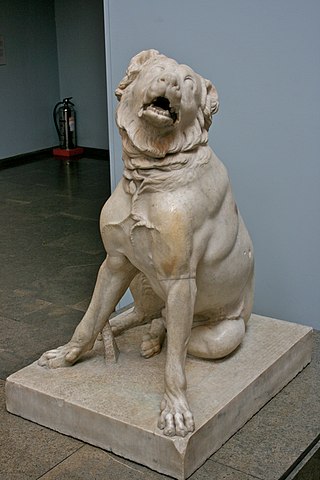Molossian hound
Dog breed From Wikipedia, the free encyclopedia
The Molossus (Greek: Μολοσσός, romanized: Molossós), also known as the Molossian hound and Epirus mastiff, is an extinct dog breed from Ancient Greece.
| Molossus | |
|---|---|
 The "Jennings Dog", a Roman copy of a lost Greek bronze statue, on display in the British Museum | |
| Other names |
|
| Origin | Epirus, ancient Greece |
| Breed status | Extinct |
| Dog (domestic dog) | |
History
Summarize
Perspective
The Molossus were dogs that were kept by the ancient Greek tribe and kingdom of the Molossians, who inhabited the region of Epirus.[1][2]
The Molossus were famous throughout the ancient world for their size and ferocity and were frequently mentioned in ancient literature, including the writings of Aristophanes,[3] Aristotle,[4] Grattius,[5] Horace,[6][7] Lucan,[8] Lucretius,[9] Martial,[10] Nemesianus,[11] Oppian of Apamea,[12] Plautus,[13] Seneca,[14] Statius,[15][16][17] Ovid,[18] and Virgil.[19] The Molossians issued silver coinage with an image of a Molossus as their emblem.[1]
It is sometimes stated in books and magazines, particularly in Continental Europe and North America, that all mastiff-type dogs are descended from the Molossus.[1][2] This theory states that the breed's progenitors arrived in Molossia from Asia and were eventually discovered by the Romans who employed large numbers as guards for the Roman Army; this theory speculates that the various mastiff breeds found throughout Europe descend from dogs left behind by the Romans.[2] This theory has been questioned by many experts who state it relies on guesswork and lacks historical evidence, and that mastiffs likely developed elsewhere.[1][2]
Another story is that in the course of his military conquests Alexander the Great discovered some giant dogs in Asia that impressed him so much that he sent some home; as the son of a Molossi princess these dogs became associated with his mother's people and that it was from these dogs that all mastiffs descend.[2]
It seems most likely that Molossi kept two distinct types of dogs, one a hunting dog with a broad muzzle which resembled something in between a Great Dane and a heavily built Saluki, the other a large livestock guardian dog.[1][2] Aristotle in his History of Animals wrote "In the Molossian race of dogs, those employed in hunting differ in no respect from other dogs; while those employed in following sheep are larger and more fierce in their attack on wild beasts."[1][4] He also added that dogs that are born of a mixed breed between the Molossian and the Laconian dogs are remarkable for courage and endurance of hard labour.[4]
Polycrates of Samos imported Molossian and Laconian dogs to the island.[20]
According to Greek mythology the goddess Artemis gave to Procris a dog, Laelaps, that never failed to catch its prey and from this dog derived the Molossian and Laconian hounds.[21]
Modern kennel club classification
A number of modern kennel clubs, including the Fédération Cynologique Internationale, group the distinct mastiffs with livestock guardian dogs as a single type they call "molossoid".[1][22][23] It has been theorised that this confusion is due to mistranslations of ancient texts and assumptions based solely on size.[1][22]
See also
References
Wikiwand - on
Seamless Wikipedia browsing. On steroids.
